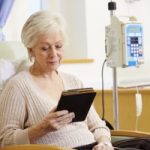 With any kind of medical treatment, it’s crucial that doctors are able to monitor patients for any sign of deterioration, and this is especially so with something as serious as cancer. A recent study from the University of Pittsburgh highlights how the sensors built into an average smartphone can be used to monitor for worsening symptoms in patients undergoing chemotherapy.
With any kind of medical treatment, it’s crucial that doctors are able to monitor patients for any sign of deterioration, and this is especially so with something as serious as cancer. A recent study from the University of Pittsburgh highlights how the sensors built into an average smartphone can be used to monitor for worsening symptoms in patients undergoing chemotherapy.
The paper highlights how the smartphone of patients can monitor their behaviors and provide real-time estimations of symptoms and side effects that give doctors the chance to intervene much earlier, and therefore reduce unnecessary hospital visits and improve the patient’s general quality of life.
The study saw a pool of participants, all of whom were undergoing chemotherapy for gastrointestinal cancer. Each was asked to carry a smartphone for a month whilst they went about their lives. Each phone was equipped with software developed by the researchers to collect data on behavior patterns, including calls and SMS usage, the apps used and the general movements of the phone.
Alongside this monitoring, each participant was asked to rate the severity of 12 common symptoms each day, ranging from fatigue to nausea. This data was then collected alongside the smartphone data to train an algorithm that could correlate certain behaviors with high symptom days. After some training, it was able to do this with 88% accuracy.
“We found that on days when the patients reported worse-than-average symptoms, they tended to spend more time being sedentary, moved the phone more slowly, and spent more minutes using apps on the phone,” the authors say. “Collecting these objective behavioral measures from smartphone sensors requires no additional effort from patients, and they could prove beneficial for long-term monitoring of those undergoing arduous cancer treatments or those with other chronic illnesses.”
The team hope to conduct a series of follow-up studies to examine whether this form of passive sensing can also help to identify complications after people have cancer surgery. They are also working with a number of healthcare providers to see how their work can be integrated into care pathways.